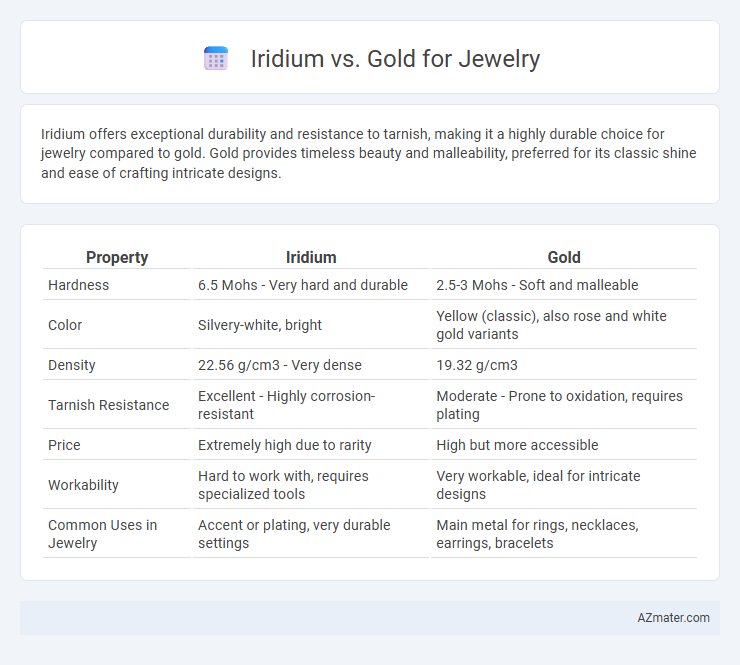Iridium offers exceptional durability and resistance to tarnish, making it a highly durable choice for jewelry compared to gold. Gold provides timeless beauty and malleability, preferred for its classic shine and ease of crafting intricate designs.
Table of Comparison
| Property | Iridium | Gold |
|---|---|---|
| Hardness | 6.5 Mohs - Very hard and durable | 2.5-3 Mohs - Soft and malleable |
| Color | Silvery-white, bright | Yellow (classic), also rose and white gold variants |
| Density | 22.56 g/cm3 - Very dense | 19.32 g/cm3 |
| Tarnish Resistance | Excellent - Highly corrosion-resistant | Moderate - Prone to oxidation, requires plating |
| Price | Extremely high due to rarity | High but more accessible |
| Workability | Hard to work with, requires specialized tools | Very workable, ideal for intricate designs |
| Common Uses in Jewelry | Accent or plating, very durable settings | Main metal for rings, necklaces, earrings, bracelets |
Introduction to Iridium and Gold in Jewelry
Iridium and gold are two distinct metals used in jewelry, each offering unique properties and aesthetic qualities. Gold is prized for its rich luster, malleability, and resistance to tarnish, commonly alloyed to enhance durability for everyday wear. Iridium, a rare and dense platinum-group metal, is valued for its exceptional hardness, corrosion resistance, and bright silvery-white appearance, often used as a plating or alloy to improve the strength and longevity of fine jewelry pieces.
Chemical Properties: Iridium vs Gold
Iridium exhibits exceptional corrosion resistance and chemical inertness, making it one of the most durable metals used in jewelry, with a melting point of 2,446degC and a density of 22.56 g/cm3. Gold, with a melting point of 1,064degC and a density of 19.32 g/cm3, is highly malleable and resistant to oxidation but is softer and more prone to scratching compared to iridium. The distinct chemical properties of iridium, including its resistance to acids and tarnishing, make it ideal for long-lasting, low-maintenance jewelry, whereas gold's chemical stability contributes to its traditional popularity and ease of crafting intricate designs.
Durability and Hardness Comparison
Iridium exhibits exceptional durability and hardness, ranking near the top on the Mohs scale, making it highly resistant to scratching and deformation in jewelry applications. Gold, particularly in its pure form (24k), is much softer and more prone to wear, often alloyed with other metals to enhance strength for everyday use. Jewelry crafted from iridium offers superior longevity and resistance to damage compared to gold, particularly in high-impact or frequently worn pieces.
Color and Aesthetic Differences
Iridium jewelry exhibits a unique silvery-white luster that remains bright and tarnish-resistant, offering a sleek and modern aesthetic distinct from traditional metals. Gold, available in various hues such as yellow, white, and rose, provides warm tones that enhance classic and luxurious designs. The color palette of iridium suits minimalist and futuristic styles, while gold's rich color variations complement vintage and opulent jewelry pieces.
Hypoallergenic Qualities
Iridium and gold differ significantly in hypoallergenic properties, with iridium being a rare, naturally hypoallergenic metal often used to alloy with platinum for enhanced durability and reduced skin irritation. Gold, especially in higher karats (18K and above), is generally hypoallergenic, but lower karat gold alloys contain metals like nickel that can cause allergic reactions. For sensitive skin, iridium's biocompatibility and resistance to corrosion make it a superior choice, whereas gold's hypoallergenic potential depends largely on its purity and alloy composition.
Rarity and Market Availability
Iridium is one of the rarest elements on Earth, with a crustal abundance of approximately 0.001 ppm, making it significantly scarcer than gold, which has a crustal abundance of about 0.005 ppm. Gold dominates the jewelry market due to its widespread availability, established supply chains, and consumer recognition, whereas iridium's rarity and limited production (only a few tons annually as a byproduct of platinum mining) restrict its use primarily to industrial applications and niche luxury pieces. The high market demand and liquidity of gold contrast sharply with iridium's niche status, leading to greater accessibility and higher turnover in gold jewelry markets globally.
Price and Value Considerations
Iridium is significantly rarer and more durable than gold, but its price in jewelry markets is generally lower due to limited consumer demand and recognition. Gold's established status as a precious metal with high liquidity ensures consistent value retention and higher market prices. While iridium offers exceptional hardness and resistance to tarnish, gold remains the preferred choice for investment and resale value in fine jewelry.
Workability in Jewelry Design
Iridium offers exceptional hardness and scratch resistance, making it highly durable but challenging to work with in intricate jewelry designs. Gold's malleability and ductility provide superior ease for artisans to shape, engrave, and customize detailed pieces. The contrasting workability often leads designers to prefer gold for flexibility while reserving iridium for accenting or enhancing durability in specific components.
Maintenance and Care Requirements
Iridium jewelry requires minimal maintenance due to its exceptional corrosion resistance and hardness, making it highly scratch-resistant and less prone to tarnishing compared to gold. Gold, especially in higher karats, demands regular polishing and cleaning to prevent scratches and maintain its lustrous appearance, and it is more susceptible to scratching and denting. Iridium's durability makes it ideal for everyday wear with low upkeep, whereas gold needs careful handling and periodic professional care to preserve its shine.
Pros and Cons: Iridium vs Gold for Jewelry
Iridium offers exceptional hardness and corrosion resistance, making it ideal for durable, scratch-resistant jewelry but is rarer and more expensive than gold. Gold provides timeless appeal, excellent malleability, and hypoallergenic properties, yet it is softer and prone to scratching and wear over time. Choosing between iridium and gold depends on preference for durability versus traditional aesthetics and ease of crafting.

Infographic: Iridium vs Gold for Jewelry
 azmater.com
azmater.com